TTL vs manual flash: what’s the difference?
What is the difference between the two main types of flash exposure mode?

Flash photography can be complicated, unpredictable, and unflattering, and it’s chock-full of complex jargon and acronyms. Then there's also the question of kit. Do you use the best flashgun or strobe, with the best flash triggers?
To get the most from your camera’s flash system, you have to understand how it works. There are two main ways to expose with flash: by setting it to Manual mode (where available), where you control the power of the flash yourself; and TTL (Through-The-Lens) flash mode, where the camera measures the brightness of the flash being reflected into the lens and automatically adjusts the output.
The advantage of a TTL flash exposure is that your camera will fine-tune the flash exposure to compensate for any filters on the lens or light modifiers such as softboxes and umbrellas in front of a flashgun. Unlike manual flash, you don’t have to spend time working out the exposure if you change the aperture or the distance between the flash and the subject: as long as you’re close enough, the camera maintains a consistent exposure.
TTL vs manual flash: what's the difference?
With a TTL (Through-The-Lens) flash exposure, the camera takes care of everything; it calculates the exposure and will, within reason, compensate for any changes you make to the aperture, shutter speed or ISO, and the distance between you and the subject, in order to maintain a consistent flash exposure.
As the name suggests, with a manual flash exposure you have to set the flash power yourself. The camera won’t make any adjustments, so if you move the flashgun closer to the subject or further away, for instance, or you raise or lower the ISO sensitivity on the camera, the flash exposure will change.
The camera doesn’t have to be set to Manual exposure mode to use a manual flash exposure, nor does it have to be in a semi-automatic mode such as Aperture Priority to use automated TTL flash. Use manual flash when you need consistency, and TTL when you need to work quickly.
Use the handy infographic above to see this all for yourself. And make sure to keep us bookmarked for more great photography cheat sheets.
The best camera deals, reviews, product advice, and unmissable photography news, direct to your inbox!
Adjusting the flash exposure
You can make the flash exposure brighter or darker, but the way in which you do this depends on the flash exposure mode. As TTL metering takes the camera settings into account, your options are more limited, but TTL can be less time-consuming

| - | To reduce the flash exposure, use… | To increase the flash exposure, use… |
|---|---|---|
| TTL | Negative Flash Exposure Compensation (FEC) (on some cameras, the regular exposure compensation setting also affects the flash exposure). | Positive Flash Exposure Compensation (FEC) |
| Manual | • A smaller aperture • A lower ISO sensitivity • A lower flash power • A softbox or similar modifier … or move the flash further away | • A larger aperture • A higher ISO sensitivity • A higher flash power … or move the flash closer |
You might also like to read: the exposure triangle explained, how to understand f-stops and our general Photography tips and tricks.

Lauren is a writer, reviewer, and photographer with ten years of experience in the camera industry. She's the former Managing Editor of Digital Camera World, and previously served as Editor of Digital Photographer magazine, Technique editor for PhotoPlus: The Canon Magazine, and Deputy Editor of our sister publication, Digital Camera Magazine. An experienced journalist and freelance photographer, Lauren also has bylines at Tech Radar, Space.com, Canon Europe, PCGamesN, T3, Stuff, and British Airways' in-flight magazine. When she's not testing gear for DCW, she's probably in the kitchen testing yet another new curry recipe or walking in the Cotswolds with her Flat-coated Retriever.

